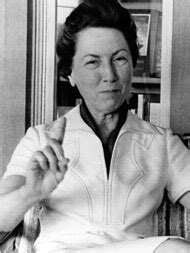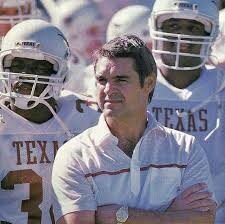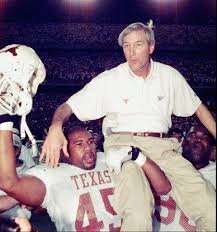Politics, Infractions, perceptions, and deceptions during the years 1976-1986 start the slow decline of Longhorn football that does not end until 1998.
The Hiring of Fred Akers
After Regent Erwin was replaced with Regent Shivers, Texas's sports dynamics changed forever. But, Kirk Bohls says, "where Shivers was smoother than mink, Erwin was as subtle as a bulldozer." Erwin led the University specializing in micromanaging and intimidation, and it worked. Most of the time, he got his way, and his decision moved U.T. building projects forward.
However, when ex-Governor Shivers was elected to chair the Board of Regents, Erwin's precise control of decision-making gave way to academia "groupthink." Groupthink is a psychological phenomenon that occurs within a group of people who desire harmony or conformity. This causes the group to minimize conflict and reach a consensus decision without critical evaluation. With Royal's resignation, Texas changed from an open collar institution to a buttoned-down corporate university with an influential Athletic Director and a hands-on university president. The media coined the phrase "Texas Inc." to capture U.T.'s new power base, and all were collectively branded as "suits."
U.T. leaders (suits) Shivers, Frank Erwin, and UT president Lorene Rogers resented Royals’s power and popularity that they felt burnished the university’s image. They were ecstatic when Royal resigned. The “suits” were tired of Royal's national image of eating at Mexican food dives, wearing casual attire, partying with country music outlaws, and associating with blue-collar fans. Moreover, the "suits" thought that Royal's image painted U.T. with a mosaic brush that was more representative of Sul Ross than a first-tier University. DKR, academia said, was too folksy.
On the other hand, Fred Akers was a "suit," a Texas Inc. type of guy; an image welcomed in academic circles. Akers looked like a Neiman Marcus model, well-manicured, dressed to a 10, and wearing a jacket with a tie. He looked like a bonsai garden.
Doug Shankle, a player for Coach Akers, said, "When you saw Coach on the field, it was the polo shirts with the long pants and the clean cap. Fred looked good and spoke better. He was also a contemporary thinker tuned to coaching styles emanating from West Coast sports psychologists. Akers was a positive thinker using visualization and deep relaxation taught by “new Age leadership to enhance a winning attitude.
Fred's interview won over the Board of Regents member Shiver, and for President Lorene Rogers, it was love at first sight. Lorene turned to Shivers and said, "That's the image I want." Coach Akers was hired. Thus, he began a ten-year reign by a 5 foot 9 coach called "little Napoleon” by his players. A coach so optimistic he would make Dale Carnegie look negative.
After Coach Akers was hired, the rift between Royal and Akers started small, but by the time the U.T. administration, Royal Loyalist, and Longhorn fans were done, the chasm was deep and wide.
Given how Fred got the job and the legend he replaced, Akers never really had a fair chance. Kirk Bohls says, "Unlike Royal, Akers was tasked with winning at a place that had already won big, and the pressures that came with the job were magnified when he fully understood that some people in very high places weren't on board with him replacing Royal."
All coaches must deal with internal politics, influential Alumni, wealthy donors, and fanatical fans. Unfortunately for Coach Akers, a huge number of the U.T. faithful never thought Fred Akers deserved to be the head coach at U.T. Royal was perceived as a charismatic people person. Akers was not. Royal was folksy with a warm personality. Akers was not. Akers's reserved nature was interpreted as cold and arrogant, and Royal was open and homey. Akers had great qualities, but he was no Royal, and it is always hard to replace a legend. Longhorn sports are full of coaches who followed a legend and failed:
Football-Coach Price replaced Coach Cherry (fired)
Football-Coach Akers replaced Coach Royal (fired)
Football-Coach Strong replaced Coach Brown (fired)
Coach Schubert replace Coach Quick (women's swimming- quit)
Coach McCain replaced Coach Moore (women's tennis- quit)
Coach Sategna replaced Coach Beverly Kearney (fired), and
Coach Lovvern replaced Coach Littlefield (men's track-fired).
From 1977 through 1986, Akers and Royal were caught in the middle of politics, petty jealousies, power plays, egos, fan turmoil, and bad decisions.
It started when Shivers minimized Royal in a letter to the Athletic Council stating, "We hope Coach Royal will assist us in selecting the coach, and that the committee will listen to his recommendations, although not necessarily be guided by them." Then Shiver's search committee rejected Royal's recommendation to hire defensive coordinator Mike Campbell as head coach and chose not to let Athletic Director DKR vote to select Texas's next head football coach.
After Akers was hired, tensions got worse, and Royal Loyalists including the team members and readers of the Austin American Statesman successfully cast Akers as an outsider. The pro-Royal crowd was incensed at the way Dr. Rogers treated both Royal and Campbell. It was said that Shivers tried to fire Royal as A.D., but Royal denied that occurred. However, Akers believed that Shriver did try to fire DKR as Athletic Director. Shivers told Akers, "Do not pay any attention to Darrell Royal." In the end, Royal remained as A.D., but Akers never reported to Royal about the football program. Shiver reasoned that Akers's coaching style was completely different than Royal's, and so he did not want Royal, as Athletic Director, questioning decisions made by the new head football coach. Akers's boss was Lorene Rogers. Royal Loyalists were not happy.
While all the power plays were in full force, Royal chose not to provoke the situation, denying the predatory attacks against him that were spawned by the rumor mill. Bill Little said, "DKR never cut up Akers; his friends did. Kirk Bohl's said "given the circumstances in which Akers took the job in December 1976 over another preferred candidate (Mike Campbell) and the undeniable, towering legend he was expected to follow and the dirty Southwest Conference era in which he coached, Akers never really had a chance. Not a fair one."
What the Athletic Council missed about the state of Football in the SWC in the 1980s
So why was Akers fired after one lousy season during a ten-year tenure? Some answers are presented for scrutiny in the book Bleeding Orange written by John Maher and Kirk Bohls. The author's answers are not definitive or provable. Still, they offer enough information to add Fred's firing to a bestseller list for a spy novel.
Sportswriter Kirk Bohls says, "Akers was fired in 1986 after a terrific 10-year run that included two strong flirtations with a national championship and some of the best defenses in school history because the deck was stacked against this intense, driven man ……." "He didn't win as big or as much as he might have, had not so many obstacles been put in his path.”
The Athletic Council was tone-deaf to the complicated reasons recruiting quality had declined during the last three years of Akers tenure. Instead of doing their job of analyzing the complex and troubled state of the SWC, the Athletic Counsel chose Akers as a convenient scapegoat, and quite frankly, the two coaches that followed Coach Akers records continued the decline of Longhorn football.
What was too close for the Athletic Council to see was the external uncontrollable systematic factors that hurt Akers's football fortunes. To recruit the best athletes, many SWC teams raised cheating to an art form." In the 1980s, recruiting techniques had changed dramatically, resulting in a future landscape that destroyed the SWC. Recruits were bored playing in a regional conference composed of Texas schools plus the University of Arkansas. They wanted to play in conferences with more national scope and full stadiums instead of half-full stadiums at Rice, Baylor, SMU, TCU, and Tech.
By the mid-1980s, the SWC was so tainted that homebred football talent began fleeing to other states, an exodus that has not stopped. In 1986, the state of Texas had 12 recruits ranked among the top 100 nationally, and seven of them left the state to play their college ball. In the first seven years (1977-1983) of Akers reign Aker's recruited many 5 star athletes. The 1983 NFL draft including 17 Horns, with 5 of those drafted in the first round. Akers last two years, he only signed one blue-chip athlete.
The SWC earned the reputation of being the worst conference for NCAA violations, which is not an excellent recruiting point for impressionable high school athletes and their parents. The SWC was tagged with the moniker "Rags and Rides," embarrassingly, the tag worked, with some talented athletes choosing "gifts" over consciousness. Eric Dickerson and Craig James are prominent examples of "rags and rides, "but many other elite athletes received pay-to-play that did not gain notoriety.
The NCAA rule in 1973 imposing a limit of 105 scholarships for football programs, essentially freeing up money for scholarships in other sports, especially women's sports, hurt the Horns more than other SWC universities. In addition, Title IX of the Education Amendments of 1972 had forced the hands of university presidents and athletic directors, mandating that they more equitably distribute resources--including athletic scholarships--among different sports and sexes.
In 1978 football scholarships were, reduced to 95, and again in 1992, with football scholarships limited to 85. These rule changes changed college football's landscape helping Colorado challenge Nebraska and O.U. for supremacy in the Big 8. So assisted Georgia Tech's challenge to win a national championship and helped Southern Mississippi beat Alabama and Auburn.
The prominent universities now had to win by recruiting quality, not the number of athletes. With the rule changes, Texas could no longer hoard 50 talented freshmen and starve other SWC teams of quality players. Instead, Texas was forced to concede 25 good athletes every year who would have joined Texas under the 50 scholarship rule to other college football programs. In the SWC, Texas and Texas A & M recruiting were damaged the most by these rule changes. Texas A & M's coach Slocum says about the 25 player rule, "It's hard for fans to accept that. They have a hard time accepting the reality of parity. "Fans can create a lot of turmoil. Your own fans can cause your program problems because they can be such a negative thing."
Texas was forced to realign its recruiting tactics and strategy from fishing with a net to fishing with a pole. Indeed, Texas was so spoiled after decades of using a net that Texas Coaches struggled to formulate fishing pole recruiting techniques. Thus, by 1985 the perfect storm occurred, and poor recruiting tipped the scale, and Longhorn football was poor to average for the next 13 years.
The Firing of Coach Akers
According to Aker’s head recruiter James Blackwood, part of the cause of the downturn in quality recruiting was precipitated by some Texas alumni telling kids not to come to Texas. James Blackwood says. "they thought they were hurting Fred Akers, but mostly they hurt the University of Texas." James Blackwood was right. After the U.T. administration fired Akers, the Longhorn football program got worse, not better. Longhorn football was diseased for the next 14 years.
Deloss Dodds had prepared for this moment since 1981 when outgoing A.D. Bill Ellington said to incoming A.D. Dodd, "You've got just two problems at Texas," "one is the basketball coach (Lemons), and the other is the football coach (Akers).”
U.T. leadership's decision-making process in 1986 should be a case study of the dark side of groupthink. I doubt very seriously that anyone on the athletic council challenged the U.T. leadership's decisions to fire Coach Akers. All reasoned that Fred Akers was the cause of the decline of Longhorn football. Just Fire Akers and U.T. would return to football dominance. The Athletic Council needed someone like Spike Dykes to interject reality and challenge the groupthink process. Spike would have said to the firing committee, “there is a "simple reason why Texas had turned into a loser." "You lose if you don't recruit every year. You win with players. You don't win with buildings or stadiums or jerseys or helmets.”
Look no further for groupthink than Deloss Dodds's justification for firing Coach Akers. In the end, A.D. Deloss Dodds in his own words, summed up the reason that Aker's was fired. Deloss said about Akers, "It wasn't his coaching. It wasn't his recruiting. It was the division of people. We were so split, so unhappy. People were just not satisfied. People didn't like Fred." Since U.T. could not fire Akers for his overall record, they fired him because he was unpopular. (It sounds to me like the reasons Coach Herman was fired and is deja vu all over again). According to Kirk Bohls and John Maher's book Bleeding Orange, The meeting to fire Coach Akers was over in 10 minutes. Deloss tells Akers, "Fred, they have decided to let you go." Akers says, "Who are they?" Deloss responds, "Well, the Athletics Council, the president, and me."
In the end, there was no one in power willing to save Coach Akers. He was fired, then replaced by a favorite player of DKR, David McWilliams, a defensive tackle on the 1963 national championship team who wore jeans and boots and said, ma'am. He was folksy, loved beer, ate Mexican food at dives, dressed casually, loved Country Western music, and blue-collar fans adored him. DKR style of football was reincarnated when David McWilliams was hired.
Hindsight is a great tool for correcting mistakes made on game day. Akers was the most underappreciated football coach in program history, but History has been kind to Coach.
Hindsight makes all people smart. It has been said that Sports is the only occupation that the fans are the "experts" and not the coach. In his book Longhorn and Tall Tails, Duke Carlisle says that Fans think coaching is a "common sense" profession. With a sense of humor, he says, "fans also have certain rules they expect a coach to follow, such as don't pass if it's going to be intercepted, or never go for two unless you make it." Hindsight makes fans great coaches, and fan hindsight has cost many good Longhorn coaches their job.
See https://texas-lsn.squarespace.com/death-taxes-and-fans).
So with great hindsight, I can say with 100% certainty that the “Texas Inc.” firing of Fred Akers had to do more with politics and popularity than team results. Fred was fired for the wrong reasons. History will show, that the two coaches- McWilliams and Mackovic - produced worse records than Fred Akers. With the real reasons for the demise of Texas football not addressed by Longhorn leadership, McWilliams and Mackovic were destined to repeat the errors of the past.
Fred Akers- Mia Culpa
Once again using that hindsight fortune bowl that is perfect 100% of the time, Coach Aker’s did make some questionable decisions that scarred both the Longhorn football team and the football program.
Kirk Bohls said about Fred's offense, "I wrote with some hyperbole that the four most important things in Akers' life were first down, second down, third down and fourth down, which was usually when he'd kick a field goal. Too often for fans' tastes."
In the book “Longhorn Football” by Bobby Hawthorne the author notes “In time, the stitching that connects the UT faithful- the students and alums, the general admission fans in the nosebleed section, and the high rollers on the fifty-yard line, twenty rows up- unraveled under Akers.”
Internally, Akers struggled with poor offense, team discipline, graduation rates, inability to win "the big one, and perceived arrogance. "Augie Garrido once said there is no antidote for arrogance. Texas school official Bill Little said, "He (Akers) was misunderstood."
On discipline Donnie Little the starting quarterback, said, "with Akers, you were your own person… I remember Fred told the whole team one time that we're not going to make that dorm a whorehouse." His words were not heeded. Donnie said we had snakes in the elevators, stereos jamming all during the night. It was like one big party …… ".
"Some guys were shooting out porch lights with deer guns."
Then there was the episode in 1984 with Tony Edwards, who scuffled with police at a bar. Aker's response shocked U.T. administrators, team members, and fans. Aker's sided with Tony stating that he was innocent until proven guilty. Akers allowed Tony to play against Baylor, and #7 Texas lost to Baylor 24-10, and then Tony played in the Freedom Bowl, losing to Iowa 55-15. Coach Dabbs said this was the year that Fred lost the team. It was the worse decision Akers made in his 19-year stint with Texas. Akers should have suspended Edwards immediately.
New Beginnings after Akers- not
After the U.T. administration fired Fred, they fully expected the Longhorn football program to return to the quality of play produced during the DKR years. Instead, from 1987 through 1998, the Horns got worse. Hindsight explains the reason why. On average, Akers won 8.6 games and lost 3.1 games every year. Akers replacement, McWilliams, won 6.2 games and lost 5.2 games every year, and McWilliams replacement, Mackovic, won 6.8 games and lost 4.6 games every year. Coach Akers recorded one 5-6 record in 10 years. Williams and Mackovic recorded five 5-6 seasons. These were the years that fans who in the past expected to win started praying for a win.









